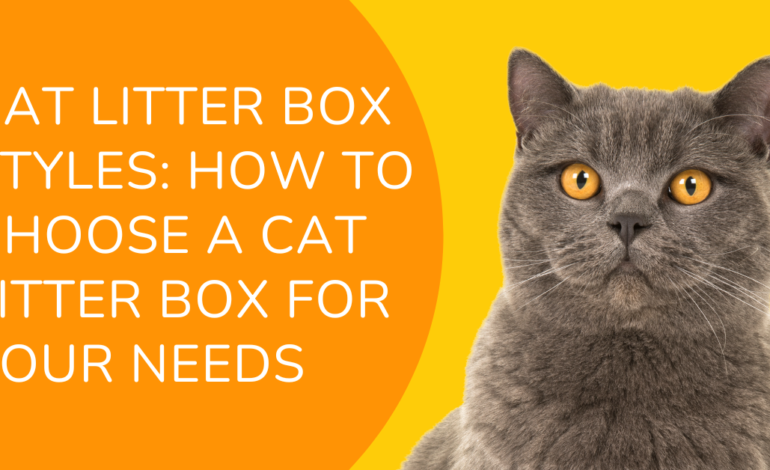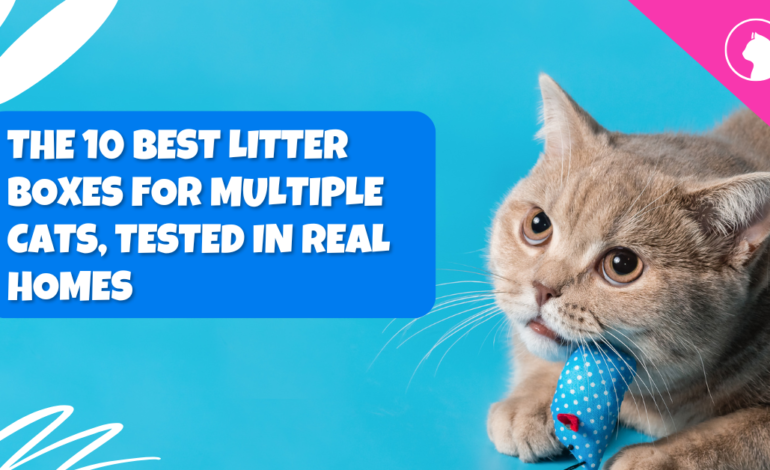Cat Litter Box Styles: How To Choose a Cat Litter Box for Your Needs
- By MeowCareHub
- March 28, 2025

Choosing the right litter box is important to keep your cat comfortable, promote healthy bathroom habits, and support your home’s hygiene. A litter box that is not right for your cat can create stress and/or discomfort, which can possibly lead to inappropriate elimination or soiling. Interestingly, cats are particular when it comes to going to the bathroom. Because there are different types of cat litter boxes available, understanding their unique benefits can help you choose the best box for you and your cat.This guide includes a look at different styles of cat litter boxes, selecting a cat litter box that fits your cat’s needs, and factors to consider in cat litter boxes like size, entrance height, and what litter is appropriate in the box. We review the pros and cons of open litter boxes, covered litter boxes, top-entry litter boxes, self-cleaning litter boxes, and sifting litter boxes, to help you find the best option for your cat.
Why Choosing the Right Cat Litter Box Matters
Cats are naturally picky about where they do their business, and picking the right litter box is important to prevent stress, house soiling, and undesirable behaviors. This is why it is especially important to select the right style of cat litter box to ensure your cat’s comfort, hygiene, and safety.A properly sized box will accommodate your cat’s instinctual behavior to eliminate in a clean and easy-to-access __cpLocation. Keeping that in mind, it is also helpful to investigate all the different types of cat litter boxes, including open trays, covered boxes, top-entry containers and self-cleaning varieties to reduce risk of messy, frustrating clean-up. Conversely, the style of box you choose, along with the right litter type (clumping, crystal, or biodegradable) will assist with odor control, and maintain a mess-free clean litter box.
Different Types of Cat Litter Boxes to Consider
Choosing the right litter box is crucial for your cat’s comfort and hygiene. Here’s a breakdown of the most popular types:
| Litter Box Type | Features | Pros | Cons | Buying Link |
| Open/Uncovered Box | Simple, easy access | Affordable, easy to clean | Less odor control | Buy on Amazon |
| Covered/Enclosed Box | Lid or hood for privacy | Contains odor, reduces litter scatter | Traps odors, can stress some cats | Buy on Amazon |
| Top-Entry Box | Entry from the top | Minimizes litter tracking | Not ideal for senior cats | Buy on Amazon |
| Automatic/Cleaning Box | Self-cleaning mechanism | Reduces cleaning effort | Noisy, may scare cats | Buy on Amazon |
| Sifting Litter Box | Separates clumps easily | Easy to clean, less litter waste | May not work with all litter types | Buy on Amazon |
| Disposable Box | Single-use, biodegradable | Great for travel, no cleaning needed | Not cost-effective long-term | Buy on Amazon |
| DIY Custom Box | Made from storage bins | Tailored to cat’s size and needs | Requires effort to create |
How to Choose a Cat Litter Box for Your Needs
Selecting the appropriate style of litter box is not only key to your cat’s comfort but can help avoid urine and fecal accidents. With so many different styles of litter boxes available, consider the following:
- Size and Space:
Your box should be one and half times your cat’s length and ideally widen enough (13-15 inches) to allow turning. Senior cats may require a larger litter box to have enough room to maneuver in and out.
- Entrance Height:
Be mindful of the entrance height based on your cat’s agility and mobility.
- Low-Entry Boxes: Ideally suited for senior or mobility-impaired cats.
- High-Entry Boxes: This is a better choice for younger and more active cats.
- Litter Box Location:
Position your litter box in a quiet, low-traffic area, and do not place the litter box in an enclosed space since the cats may feel cornered.
4. Quantity of Boxes
When sharing with multiple cats, enough boxes will discourage territorial disputes.
- For a solo cat: One box for each cat plus one box to spare.
- When managing multiple cats: Place boxes in separate areas to avoid territorial disputes.
5. Suit with Appropriate Litter Type
Accompany the box with various litter types so that your kitty can select one that matches their preferences, providing a cleaner and more enjoyable experience.
Different Litter Types to Consider
The type of litter you choose impacts your cat’s litter box habits, odor control, and overall cleanliness. Here are some common options:
| Litter Type | Texture | Odor Control | Ease of Cleaning | Buying Link |
| Clumping Clay | Soft, fine texture | High | Easy to scoop | Buy on Amazon |
| Non-Clumping Clay | Coarse texture | Moderate | Less convenient | Buy on Amazon |
| Silica Gel Crystals | Absorbs moisture effectively | Excellent | Low dust, but expensive | Buy on Amazon |
| Pellets (Paper/Wood) | Larger, firm pellets | Low | May not mask odors well | Buy on Amazon |
| Natural/Plant-Based | Eco-friendly, biodegradable | Moderate to high | Safe for kittens and seniors | Buy on Amazon |
DIY Litter Box Options: Customizing for Comfort
If your feline friend doesn’t seem to care for the commercial cat litter box options, then a DIY litter box could be a cost-effective and customizable solution. You can use a large storage bin as a platform to create the litter box that works best for them. Here are some options to consider:
✅ Low-Entry DIY Box: Is ideal for senior cats or cats with mobility problems. It is easier for them to get in and out, provides them with comfort, and may help them use the litter box more regularly without discomfort.
✅ High-Sided DIY Box: This is great for keeping litter contained when a cat may scratch or dig aggressively in their litter box. This option allows the litter to remain in the litter box while your kitty digs, digs and kicks, potentially getting litter everywhere.
✅ Covered DIY Box: Provides privacy for the kitty and keeps the smells contained from outside based on what kind of used litter the kitty generated. Make sure there is plenty of ventilation and that the cat can still see out of the litter box so the kitty does not feel trapped.
💡 Tip: A great idea might be using different litter in conjunction with the DIY box to ensure the kitty is as comfortable as possible in the space you have created for them. By customizing a litter box to their size and adjustment needs you can ensure your cat is comfortable, is contended consistently and their risk of developing litter box aversion is significantly reduced.
When to Replace Your Cat’s Litter Box
Whatever design you choose for your cat litter box, recognizing when to replace it is key to hygiene and in reducing odors. Since the plastic used in litter boxes becomes scratched and grooved, and these surfaces trap odors and bacteria, they need to be cleaned regularly but with diminishing effectiveness. Ideally, the litter box should be replaced yearly. But if you notice deep scratches, unpleasant odors, or excessive wear and tear before a year, you might want to replace the box earlier. Routine cleaning, like washing the box with mild soap and water, can make the litter box last longer, but take care not to use harsh chemicals that will leave odors behind to deter your cat from using the box. No matter what type of style you opt for your cat litter box, whether open, covered, top-entry, or even a makeshift box, you need to evaluate the condition of the box as well as the litter you are using in order to accommodate your cat’s comfort and purposes of using the box.
Mistakes to Avoid When Choosing a Cat Litter Box
- Choosing a Too Small or Totally Enclosed Box: Cats need room to be able to move around freely. A too small or fully enclosed box can stress or discomfort the cat.
- Choosing Automatic Litter Boxes: Certain automatic self-cleaning litter boxes are very loud and will scare a cat so that the cats will avoid it.
- Not Taking Box Size and Litter Type into Account: The litter box must be no less than 1.5 times larger than your cat and the litter should be of a type that suits your cat’s preference for easy maintenance and regular use.
- Positioning Box in Wrong Location: Refrain from positioning your litter boxes near noisy or heavily trafficked areas or directly in front of food or water. Cats like quiet and convenient access to their areas.
- Too Few Litter Boxes: In households with multiple cats, one litter box per cat plus one box is the recommended ratio. This avoids prospective territorial fighting and intrusion for some cats who do not want to use the box.
Conclusion: Choose the Best Litter Box for a Happy Cat
It’s best to select the cat litter box type so your cat will be safe, at ease, and stress-free. Regardless of which open, covered, top-entry, or automated box you choose, consider the size, age, mobility, and preference of your cat so you can pick the best. Cats are naturally finicky about their bathroom routines and spending some time selecting the box that best suits your cat will prevent litter box aversion and behavioral problems. We also suggest you learn what different types of cat litter boxes are and experiment with the different kinds of litter to guide you in finding the combination that is best for your cat. A well-placed cat litter box that functions ideally for your kitty equals a happy kitty and an odor-free home for you.
FAQs: Choosing the Right Litter Box for Your Cat
1. How large a litter box does a big cat need?
Ensure your litter box is larger than 1.5 times your cat’s body length. Large cats need you to attempt to select at least 23-24 inches or larger.
2. Are covered litter boxes detrimental to cats?
Some covered boxes will trap odors, and this can make them less desirable for the cat to use. A covered box may also restrict the sightlines of the cat, and this can leave them feeling exposed.
3. Can elderly cats use top-entry litter boxes?
No, elderly cats will have difficulty getting into a top-entry or side-entry box from standing height because of their mobility. A shallow-entry box would be best.
4. How frequently should I change the litter box?
For plastic boxes, change boxes every once a year, or sooner if you have deep scratches or smell strong odors emanating from it.
5. Are automatic cleaning litter boxes worth it?
They can be convenient; however, some cats will be scared of the box because of motion or noise. They might work for calm cats, but likely not others.
6. Can I employ a homemade litter box for my cat?
Yes, you can make a homemade box according to your cat’s requirements. Most of the time, senior or big cats accommodate a homemade box quite well.
7. How many litter boxes do I need to have, if I have more than one cat?
A general rule of thumb is one box per cat, and then an extra box to serve to help minimize competition and domination.





